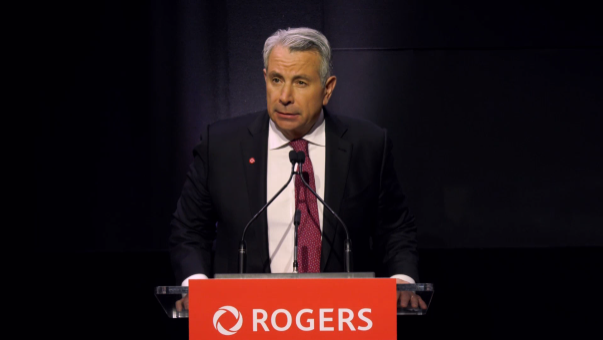
By Ahmad Hathout
OTTAWA – Rogers CEO Tony Staffieri said Wednesday the company is weighing its options, including possibly appealing a decision by the CRTC to pick Quebecor’s rate for access to the national carrier’s wireless network.
“We’re reviewing it,” Staffieri said about the decision. “As you would expect, we’re considering next steps, including potential appeals.”
The regulator said in its decision that while both offers for access met the policy objectives, it was Quebecor’s price that provided the regional player with an opportunity to market more data and therefore more plans.
Rogers said in its original pricing pitch that it baked into its offer the need for it to recover its operating and capital costs. The CRTC replied that it “does not necessarily have to ensure that costs are recouped over the short term for a rate to be considered just and reasonable” under the Telecommunications Act.
But Staffieri followed up those comments to analysts on the company’s second-quarter conference call by saying Rogers will not be distracted in its goal of plowing ahead with the integration of Shaw and taking market share across the country.
This quarter is the first full one since the closing of the acquisition of the western Canadian telecom in early April.
Staffieri noted that the company is encouraged about “some early successes and wins” since that closing, including the company making market share gains in western Canada.
“We have seen a very good shift in market share in the west, particularly if you look in BC and Alberta,” the CEO said.
“On a regional basis, our market share gains on a net add perspective is up double digit in terms of points in each of BC and Alberta. And that’s for a number of reasons: Not just the bundling opportunities, but as we focus on new to Canada, the primary areas are clearly focused in Vancouver and Toronto as the major destination markets,” Staffieri said, alluding to strong immigration numbers.
“And those are two strongholds that we do particularly well in that segment and so we’re pleased with the share that we’re getting on new to Canada and that’s distributed amongst those two and so we’re pleased with the results we’re seeing there.”
Bell has also been aggressively targeting newcomers on a loyalty play by providing discounted services and SIM cards upon arrival in the country.
Rogers said it expects to continue taking market share in the coming quarters.
The company also noted that it, earlier this month, introduced Rogers internet and TV services in Shaw territory along with bundled services. Staffieri said early uptake is “encouraging.”
“Although early days, we’re encouraged by the strong store traffic, as loyal Shaw and Rogers customers look to bundle more services given our stronger value proposition in the west,” Staffieri added. “I expect this interest will continue as we make good progress on integrating our networks and systems to offer a seamless customer experience.”
Compared to last year’s quarter that ended June 30, Rogers saw a revenue increase of 30 per cent to $5 billion in the quarter, thanks to strong wireless and cable results. Net income was down 73 per cent to $109 million, attributed to the Shaw transaction.
Compared to the same period last year, wireless revenues were up 10 per cent to $2.4 billion, cable was up 93 per cent to $2 billion, and media was up 4 per cent to $686 million. Total service revenue was up 32 per cent to $4.5 billion.
The cable company added 170,000 net new postpaid mobile wireless subscribers, an increase of 48 per cent, for a total base of 10.1 million. Its churn – or the rate at which subscribers leave the company – was up slightly to 0.87 per cent.
The company added a gross total of 231,000 prepaid subscribers in the quarter, but overall lost on net 5,000 such subscribers on a year-over-year comparison. The total prepaid base sits still higher at 1.24 million.
The monthly mobile average revenue per user was down $2 to $56.79.
Rogers also saw a major jump in number of homes passed with its internet infrastructure, to 9.8 million. However, it added 1,000 fewer net new retail internet subscribers for a quarter total of 25,000. The total retail base as of the end of the quarter sits at roughly 4.3 million, nearly double the figure of the second quarter last year.
The company also added 12,000 video subscriber, 9,000 fewer than the same quarter last year, for a total base of nearly double the comparable period to 2.7 million.
It also lost 29,000 home phone subscribers, 11,000 more than last year, for a total base of 1.7 million, again still nearly double the figure in the same period last year.



